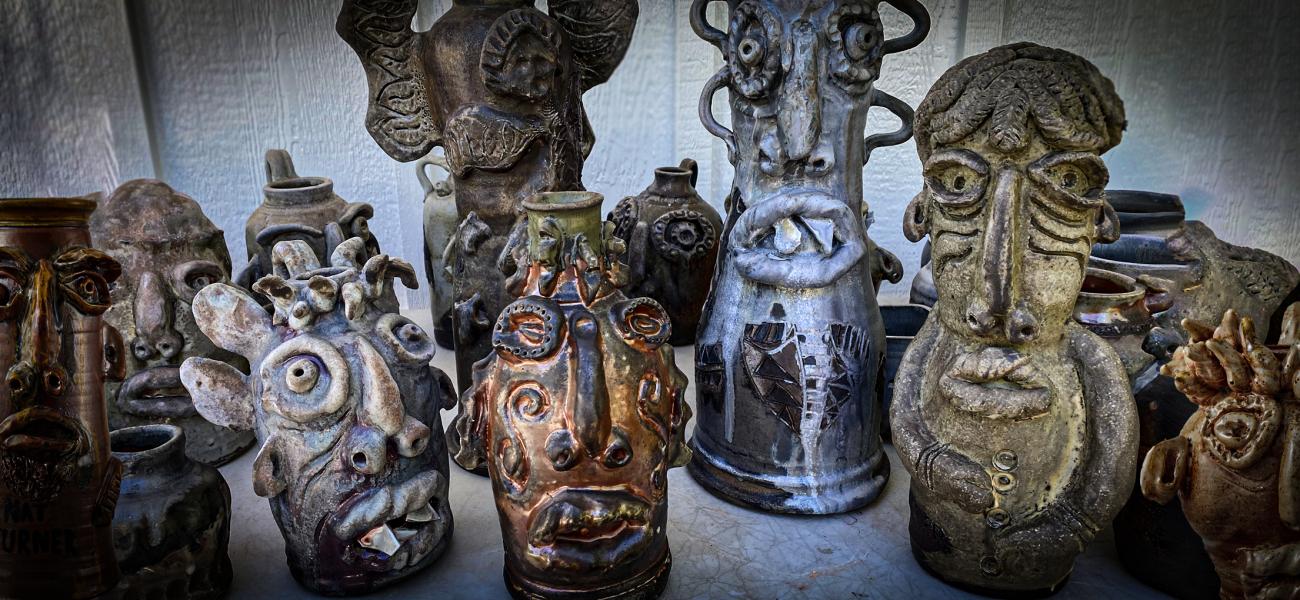This is the Ancestors’ Work – Jim McDowell
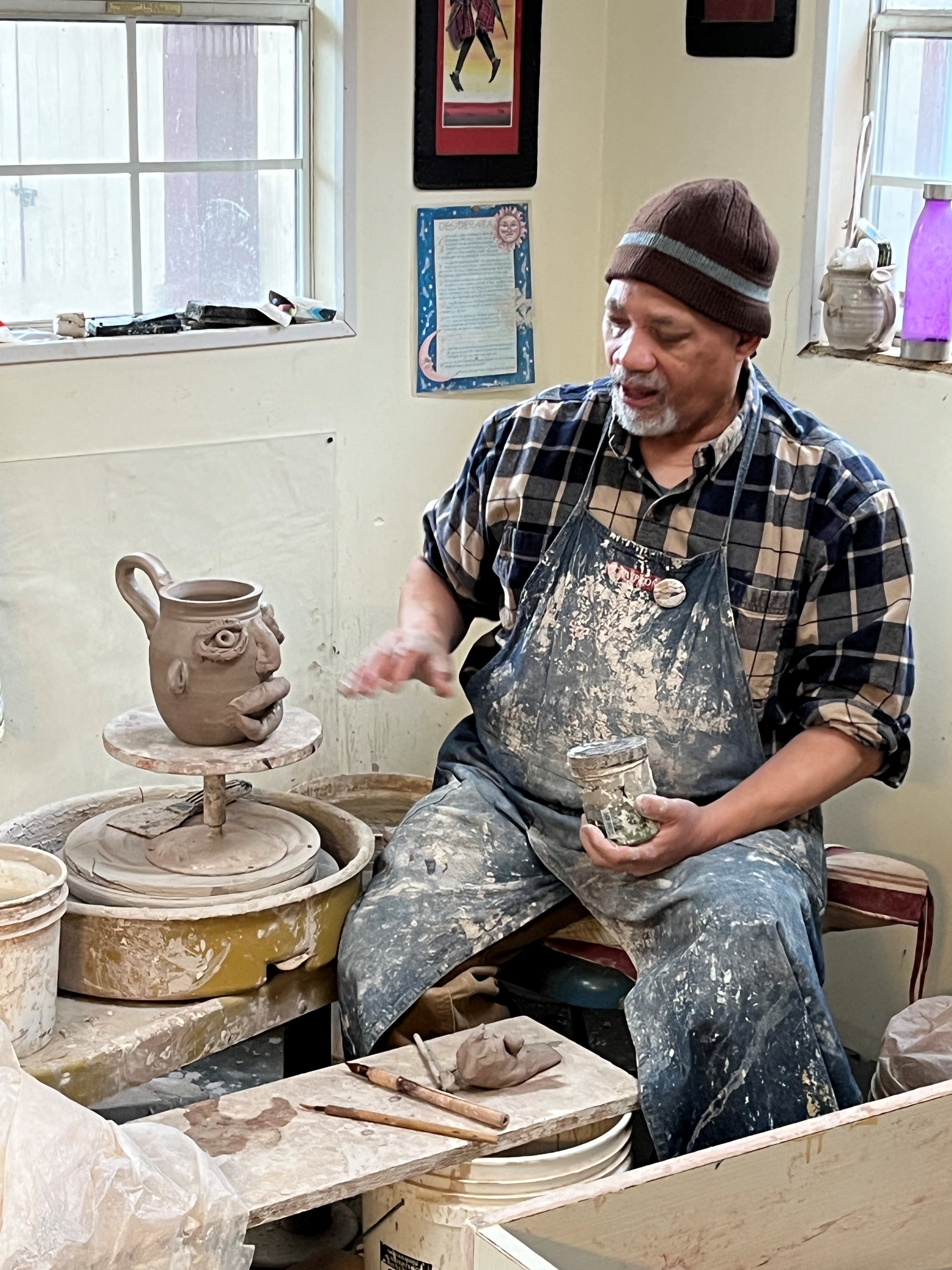 Jim McDowell has built a career that speaks to the deeply human effort of reclaiming both personal and collective histories. What stands out most profoundly is Jim’s ability to weave together autobiography, cultural commentary, and technical insight without ever flattening the complexities of any one of them. He recounts his encounters with racism, both overt and subtle, and how clay became both a refuge and a platform.
Jim McDowell has built a career that speaks to the deeply human effort of reclaiming both personal and collective histories. What stands out most profoundly is Jim’s ability to weave together autobiography, cultural commentary, and technical insight without ever flattening the complexities of any one of them. He recounts his encounters with racism, both overt and subtle, and how clay became both a refuge and a platform.
"I didn’t start out trying to reclaim anything. I just knew I had to do it. It kept me sane. And now I understand; I’m reclaiming our history one jug at a time."
His storytelling is magnetic. His voice, at once fiery, grounded, and reverent, draws me in as I listen. In speaking with Jim, there is no pretense here: Jim’s art is inseparable from his politics, his spirituality, and his sense of communal obligation. He makes clear that clay has saved his life, and in return, he has dedicated his life to giving that gift back, especially to those who have been historically excluded.
“If I don’t pass this on, it dies with me. So, I tell people, ‘Come here. Come and learn.’ I want to share it with my people first. But if they ain't coming, I'm giving it to everybody who comes. I tell people that I meet – and I try to find people of color – bring yourself here. Make pots and help me fill the electric kiln. Help me with the fire. Come here and learn. Just come here and experience this.
“Because the thing about woodfiring – whether it is full woodfiring or gas assist – when I get ready to load this kiln, how often do you get to fire in this kind of kiln? While firing an electric kiln can produce good effects, having the opportunity to work with flames, wood, and ash alongside someone else is truly special. The thing about this process is that I didn't write any of this down; I just learned by doing.”
Jim provides an example of his learn-by-doing mindset.
“There was a potter named David Hovland. Now, when I was in my thirties, I was taking these adult education classes. I think I took six in a row. He was telling me how to be at a fire. He said, ‘You take the shifts no one else wants. You do whatever they need. You bring real wood.’ Those kids were bringing wet plywood instead of real wood. [David continued] ‘You bring food. You do anything you can. You'll get in.’ Yeah, so I got in.
“I'll give you an example. I think we did one firing at David’s house, and he had an anagama kiln. And it didn't go too well. The pots looked horrible. They didn't quite get hot enough. David was going to do a re-fire the next month, and he asked me what shift I wanted, and I said I'd take the twelve-to-eight shift.
“I had a friend at the time whose father owned a sawmill, and I had access to the cut-off hardwood pieces. They were already split. This was in New Germany, Pennsylvania, so I got the truck and wood. I always go to the firing half an hour ahead of time. I came up the road, and the kiln is straight ahead. But his little shop was to the right, as soon as I hit the road, and when the crew saw the truck, they hollered, 'It's a load of wood!!' I backed the truck up to the kiln, and they made a little chute out of metal and started unloading the wood. The kiln was struggling. I think it was stalled at 1000 degrees. And with the new wood, we bumped it up to almost 2000 degrees.
“That was the beginning of learning how to be, not like in Japan, with the master and the people who help him. But it's a form of apprenticeship. And for a Black person in this country, some people call you an “Uncle Tom” (an epithet, particularly within the context of race in America, where a Black person is considered to be obedient to a white person). Well, damn it, I got into every firing I wanted to get into because they know ‘Jim knew the kiln.’
“Jack Troy, my friend and a renowned potter, once said, ‘Don't look at that pyrometer. Listen to the kiln. Listen to the kiln. Look at the chimney. Smell it.’ And he's right.
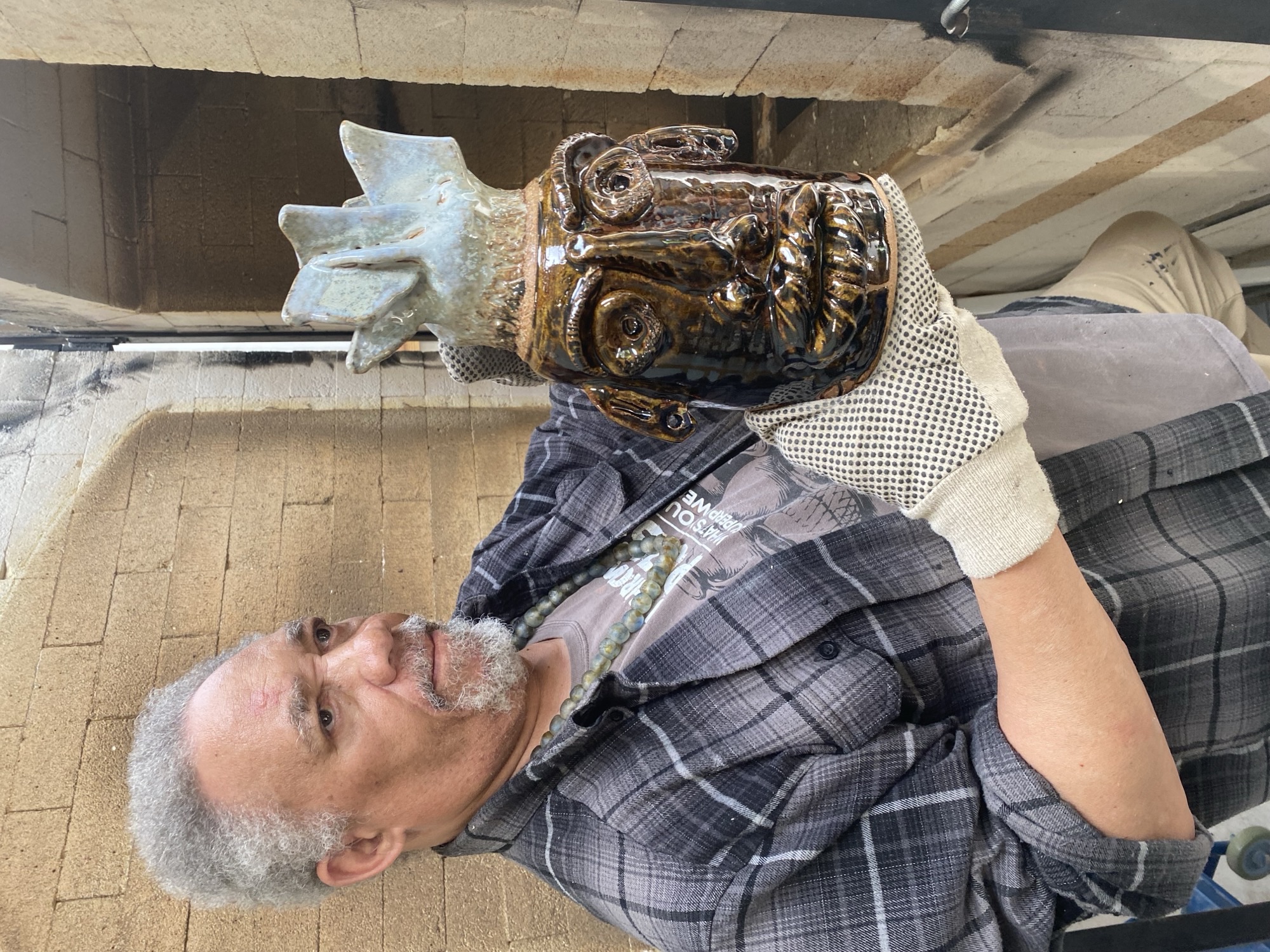 “I did a firing about a month ago at the University of North Carolina here in Asheville. And the people that were firing, they said, 'You take care of the other side. We'll take care of this side.' And they had a set schedule of when to load the wood. I'm on the other side of the kiln, and there are two stoke holes over there, and the kiln was saying, 'Feed me now!' Don't wait, you know? so I fed it, because I know what the kiln and flame need when they need it. Then I went around the other side. They said, 'What did you do?' I said, 'I fed it.' And they looked at me kind of quizzically. Then they said, 'Was it time?' I said, 'You're damn right, it was time. Feed that thing!' But sometimes people get hung up on the mechanics and aren't grounded in what is happening right in front of our faces.”
“I did a firing about a month ago at the University of North Carolina here in Asheville. And the people that were firing, they said, 'You take care of the other side. We'll take care of this side.' And they had a set schedule of when to load the wood. I'm on the other side of the kiln, and there are two stoke holes over there, and the kiln was saying, 'Feed me now!' Don't wait, you know? so I fed it, because I know what the kiln and flame need when they need it. Then I went around the other side. They said, 'What did you do?' I said, 'I fed it.' And they looked at me kind of quizzically. Then they said, 'Was it time?' I said, 'You're damn right, it was time. Feed that thing!' But sometimes people get hung up on the mechanics and aren't grounded in what is happening right in front of our faces.”
Jim's understanding of being grounded is geological, genealogical, and spiritual. When he says, “Go outside, take your shoes off, and walk in the grass,” or reflects on the grounding power of clay, he's invoking a return to sensory immediacy and embodied history. In the context of the Black American experience, this grounding also becomes a form of reclamation. The act of touching the earth recalls the labor of enslaved ancestors who worked the land and recontextualizes that history of servitude in creative power.
His reverence for enslaved ancestors who labored without recognition is not nostalgic; it’s moral. He positions himself as “the bridge” between past and future, rooted in legacy but extending forward in service. Jim’s moral clarity is powerful and disarming, though it pinpoints a central tension in his journey: carrying forward the labor of cultural reclamation.
“When I started making, it was a process of reclaiming and relearning the stuff that my ancestors had done, which was cut off because of slavery. When I think about making a face jug, I remember that they had to work at the plantation. They were enslaved. These jugs were made after work. The ancestors did it on their own time, and so they used the available materials. Broken China may have been available. A glass bottle may have been available.
“The Africans who would refuse to be assimilated, they kept their words, they kept their practice, they kept their foods – they remembered and taught. They were in close proximity, and they learned from each other. And so what I've done, what I'm trying to do, is to reclaim what they did and bring it forward. We have new ways to process clay. We have new firing techniques. We have glazes that they did not have. And so I'm incorporating all that into my work and practice – to take the face jugs and take the practice back one jug at a time. Because I'm sick of the white folks who are misappropriating. I think, historically, they saw it was a good little money maker, but they didn't start it. We did. We started in Africa.”
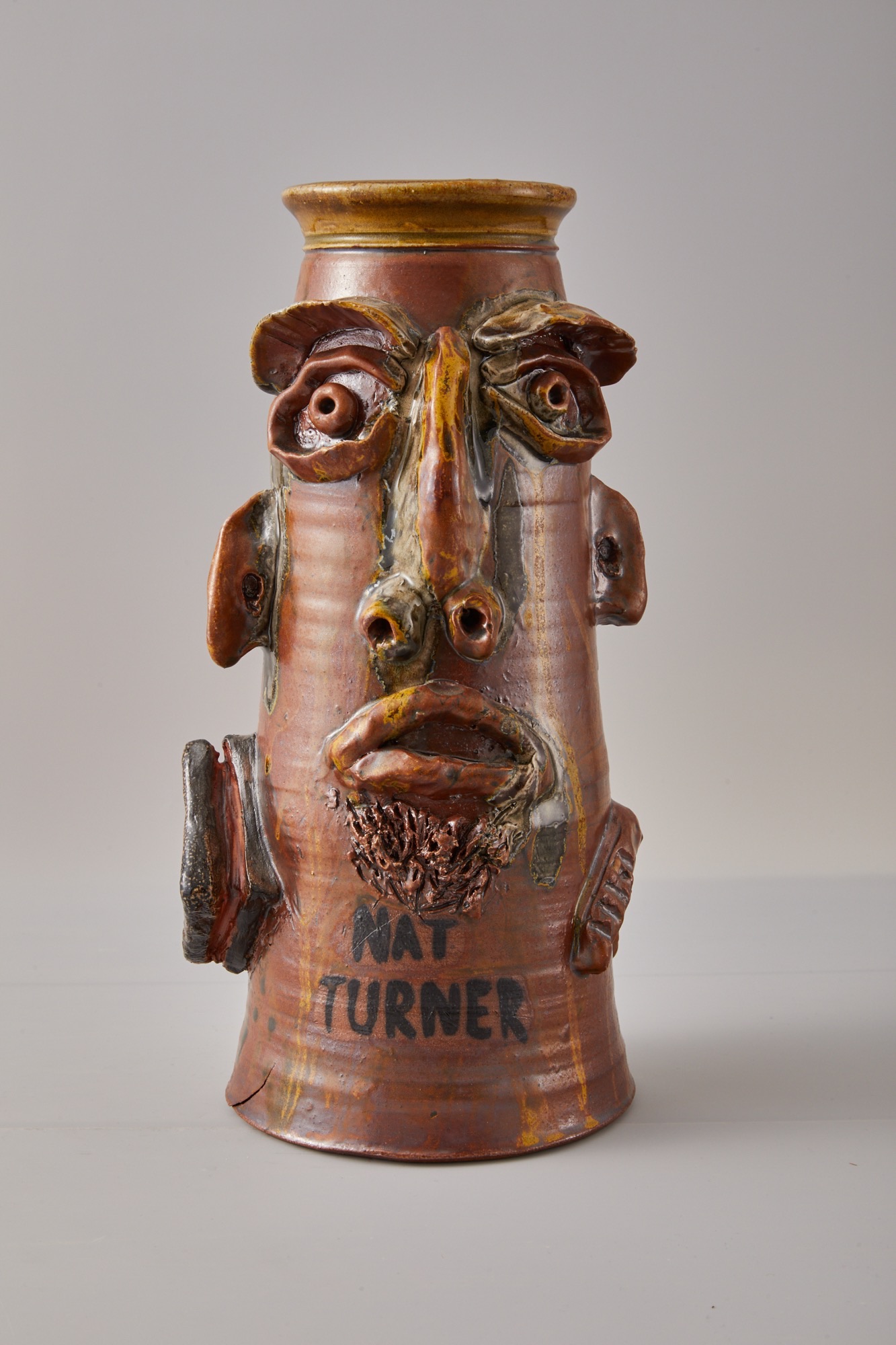 Jim first learned about his ancestral connection to face jugs at a family funeral when he was around thirteen or fourteen years old in South Carolina. His grandfather, Boyce McDowell, was a tombstone maker who had operated his own business in the 1920s. Boyce told Jim about a distant ancestor, Evangeline, Jim's four-times great-aunt, who had been an enslaved potter. Jim recalls, “Boyce was telling us the story of why the slaves were not allowed to have a grave marker because they were considered chattel, and so somebody would make a face jug and put it on the grave site.
Jim first learned about his ancestral connection to face jugs at a family funeral when he was around thirteen or fourteen years old in South Carolina. His grandfather, Boyce McDowell, was a tombstone maker who had operated his own business in the 1920s. Boyce told Jim about a distant ancestor, Evangeline, Jim's four-times great-aunt, who had been an enslaved potter. Jim recalls, “Boyce was telling us the story of why the slaves were not allowed to have a grave marker because they were considered chattel, and so somebody would make a face jug and put it on the grave site.
“Now what he explained to me, and he probably said it a different way, but I've also come to learn over the years – in Africa, they had ancestor worship, where they revered the ancestors and honored them and celebrated different things, like a victory or death or something like that; they would make ceramic vessels to honor or protect. So, when people were taken into slavery – and I don't know how long it took – but they picked up voodoo or hoodoo, which says that anything that you possess, your spirit resides in it. Then, when they took the slaves to the United States, the missionaries quickly converted them to Christianity, which has a belief in God and the devil. And so the slaves amalgamated those three religions together – ancestor worship in Africa, voodoo, and Christianity. Because they were not allowed to have a grave marker, they made face jugs, and they would put them on the grave site. The people who survived the Middle Passage changed their practice and conformed in little bits to the ways and places where they were living. But they didn't forget the old ways, you know? And so that's how it has come down to me. But I didn't see a face jug until I was in my thirties. I was at college taking adult education courses, and it was a guy from down here in North Carolina somewhere making face jugs. I didn't like them. They look white; they look soulless. And so, I said to myself, ‘Well, I can make one. Let me add features that reflect Black culture to it.' And that's when I started making them and remembering the history and remembering the story – learning as much as I can.”
This story, passed down by a grandfather rooted in memorial work, deeply shaped Jim’s understanding of clay as a spiritual and cultural material and face jugs as sacred vessels. For Jim, the face jugs are more than “little money makers” or utilitarian objects; they are tools of remembrance and resistance and a bridge between the past and future. Jim’s oral history parallels that of archaeological and museum scholars who are now acknowledging that these jugs served ritualistic purposes, such as containers for magical materials or spiritual offerings akin to Nkisi vessels, as well as aligning with Bakongo traditions of conjure and ancestral reverence.[1] Their aesthetics and symbolic power were later appropriated and diluted by white potters for commercial gain, which severed the objects from their original cultural and spiritual contexts.[2] Though Jim never states it outright, a moral thread runs through every story he tells. The moral fiber of his work is seen in a refusal to forget, to be erased, or to relinquish identity under conditions designed to destroy it.
Jim’s studio in North Carolina reflects the layered path that led him to ceramics, beginning with a formative experience in elementary school where his teacher protected his artistic vision. Jim shares, “We were the first Black family on the block – Channing Street, off North Capitol Street in the late Fifties. Growing up in Washington, DC, I think I was in about the fourth grade, and a white teacher would come to the school and bring a grapefruit-sized ball of clay and give it to us. She would show us a little bit about how to manipulate the clay, but not the wheel. Everybody in the class was making oversimplified snakes and stupid stuff, and I took my ball and carved a bird on a rock, using a popsicle stick as my carving tool.
“Everybody was pointing fingers, saying, ‘He's crazy.’ When the class was over, she stopped me at the door, grabbed me at my chest, and said, ‘You are an artist. And I'm going to tell all the teachers in the school that you have artistic ability so you won't fall down in all this stupid stuff.’ And that was the start of it. I've always liked clay, you know, always liked the malleability of it.”
With formative teachers helping him through some of his childhood barriers, Jim internally worried about his formal smarts. Throughout his school years Jim notes, “I could read the stuff, but I didn't realize – because we didn't get tested – I couldn't hear. In my final year of school, I struggled in a history class the whole year because I couldn't hear the teacher. I was rejected by the Army recruiter because of my hearing. I tried again when I was twenty-seven, guess they didn’t care then, but I didn’t get my first set of hearing aids until I was sixty.
“In school, I always positioned myself so I could hear, and I talked loudly. I asked teachers to talk louder to me. I didn't know what or why I was doing it; I just thought it was me being gregarious. In the last year of school, that history teacher, you know, she couldn't change. She wouldn't help.”
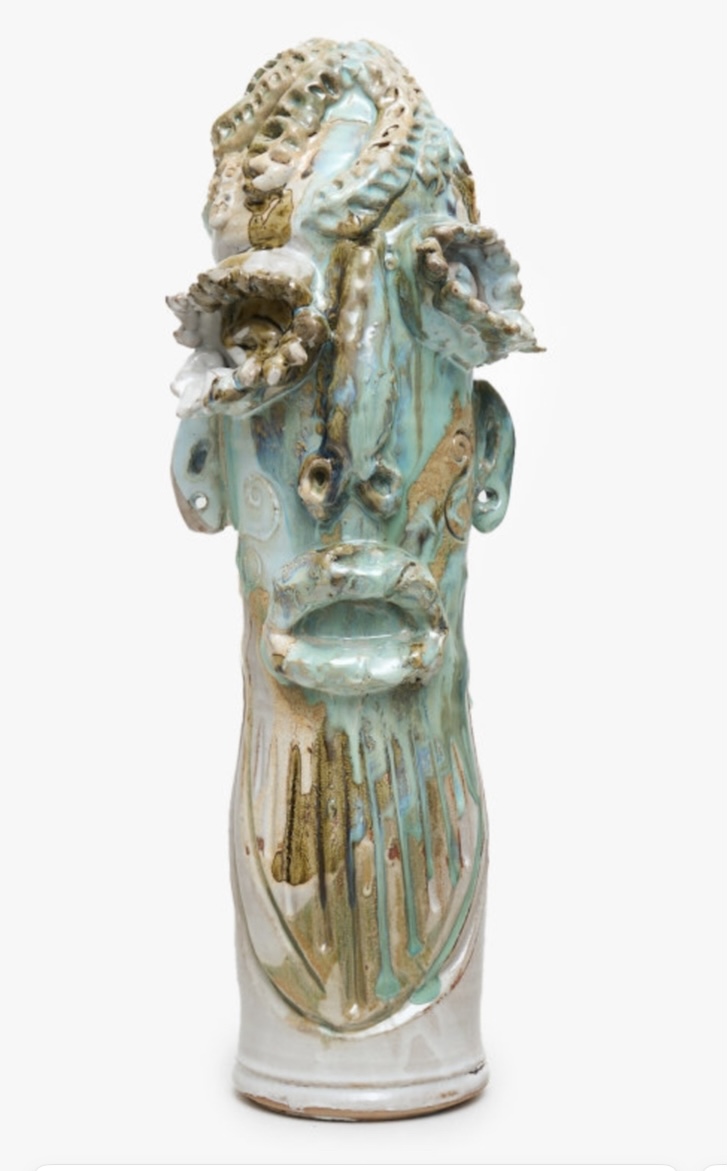 Jim reflects on his childhood and young adulthood with balance and perspective. He describes the terrible times, depression, and his refusal to perform a tolerance of injustice, yet pairs it with gratitude to potters who opened doors to woodfiring and ceramic knowledge. When I ask about the transition from his youth to professional practice, he explains, “Early on, I just was angry. This opportunity to create face jugs was a blessing from God and the ancestors. So this starts with an awareness, an awareness of self, of my practice, and the knowledge that, okay, you now have a platform.
Jim reflects on his childhood and young adulthood with balance and perspective. He describes the terrible times, depression, and his refusal to perform a tolerance of injustice, yet pairs it with gratitude to potters who opened doors to woodfiring and ceramic knowledge. When I ask about the transition from his youth to professional practice, he explains, “Early on, I just was angry. This opportunity to create face jugs was a blessing from God and the ancestors. So this starts with an awareness, an awareness of self, of my practice, and the knowledge that, okay, you now have a platform.
“You know, I remember when the Civil Rights movement came, there was a class in the Redeemer Lutheran Church in DC, designed to teach us how to be at a lunch counter. I was fifteen at the time. And so, in the class, they came to us, and as a test, they were calling us niggers and pouring water on us; they were spitting on us and doing all sorts of terrible stuff.
“I got mad.
“I failed the class because you can't get mad, because they'll kill you.
“So, I had to find something; faith and pottery were the way to [work with those feelings].
“Later on, I was being treated for depression, and the therapist that I had, he said [as it related to medicine and prescriptions], ‘Nothing works for you. Stay at that damn wheel. You don't need to do anything else. Just stay at the wheel.’ And he was right. The wheel was my salvation.”
Although Jim reflects on horrific encounters with racism and injustice, he consistently balances these stories with thoughtful reflection and gratitude, offering a narrative that plants seeds of deep wisdom and insight into the complexities of his lived experience.
“Once I was out of the Army, I found work as a coal miner near Johnstown, Pennsylvania, and with my first paycheck I bought a wheel and five hundred pounds of clay. Later, when I knew a two-week vacation was coming up, I looked and found an ad for a workshop in Weare, New Hampshire, run by a couple named David and Kathy Robinson. I could afford it, I bought a bus ticket, and left for a week. I learned so much and enjoyed it so much I stayed for two. The Robinsons, a white couple, accepted me as an artist. I was the only Black student but there was no racial BS at all. The techniques I learned from them I’m still using to this day.
“All the people that I've learned from over the years, most of them, the potters, were white. I couldn't find any at that time; there weren't any Black potters. I’ll put a name out there of two guys, Jack Troy and Kevin Crowe. Jack has invited me to his fire several times. And Jack said, 'Jim, the main thing you have to remember is that you must do your work.'
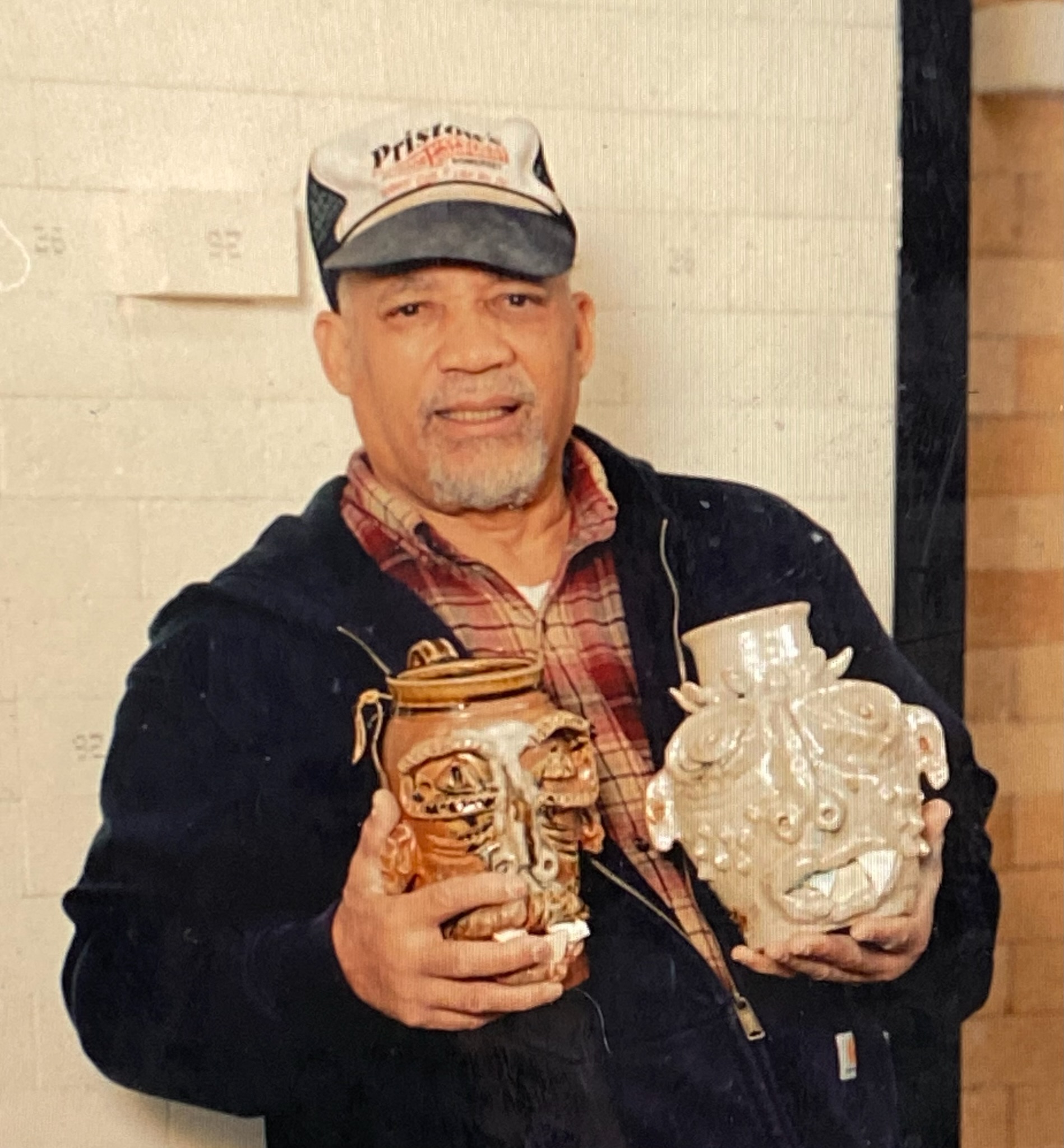 “I remember we did a firing at Touchstone Center for Crafts in Pennsylvania, and Jack and Kevin were there, and I had finished my personal work, and Jack asked if I would teach these other people how to glaze for the wood-fire. So, I helped them learn how to glaze and all this kind of stuff. But I was stuck inside during the prime loading opportunities. The kiln got loaded while I was inside helping, and I thought I had missed my opportunity, and after the firing, when we opened it up, I realized Jack had put my pot, my face jug right there in the front – the sweet spot. I said, 'Jack!' He said, 'Jim, if it had been my pot, that's where I would have wanted it.” So Jack was instrumental in helping me, and in his respect for my time and contributions.”
“I remember we did a firing at Touchstone Center for Crafts in Pennsylvania, and Jack and Kevin were there, and I had finished my personal work, and Jack asked if I would teach these other people how to glaze for the wood-fire. So, I helped them learn how to glaze and all this kind of stuff. But I was stuck inside during the prime loading opportunities. The kiln got loaded while I was inside helping, and I thought I had missed my opportunity, and after the firing, when we opened it up, I realized Jack had put my pot, my face jug right there in the front – the sweet spot. I said, 'Jack!' He said, 'Jim, if it had been my pot, that's where I would have wanted it.” So Jack was instrumental in helping me, and in his respect for my time and contributions.”
As Jim and I continue our conversation, it becomes clear that his connection to woodfiring differs from the reasons that often draw others to the flame. Though a visible joy glows from Jim as he proclaims, “I love fire; I’m a firebug,” revealing an elemental connection to a force of destruction and creation that lures many. Many people are initially attracted to woodfiring for its physical demands – the labor, the endurance – or for the aesthetic qualities it yields: the flash, the ash, and the unpredictable surfaces. However, Jim approaches it with a deeper historical consciousness.
In the Americas, particularly in the southern United States, Black potters, many of them enslaved, used traditional wood-burning groundhog kilns. These kilns were operated under the brutal conditions of plantation labor. I asked Jim, when he participates in communal firings today, what it feels like for him to stand in that lineage – to take part in a process so intertwined with both craftsmanship and historical trauma? Jim reflects, “First of all, I’m listening to the ancestors, because they were taken into slavery, and they survived. Think about that; they survived. Not only did they survive, they thrived. They made something out of nothing. They tried to work them to death and worse. And so when I think about them, I can't feel sorry for myself. And I think about the people who are yet to come.
“Secondly, I'm not enslaved.
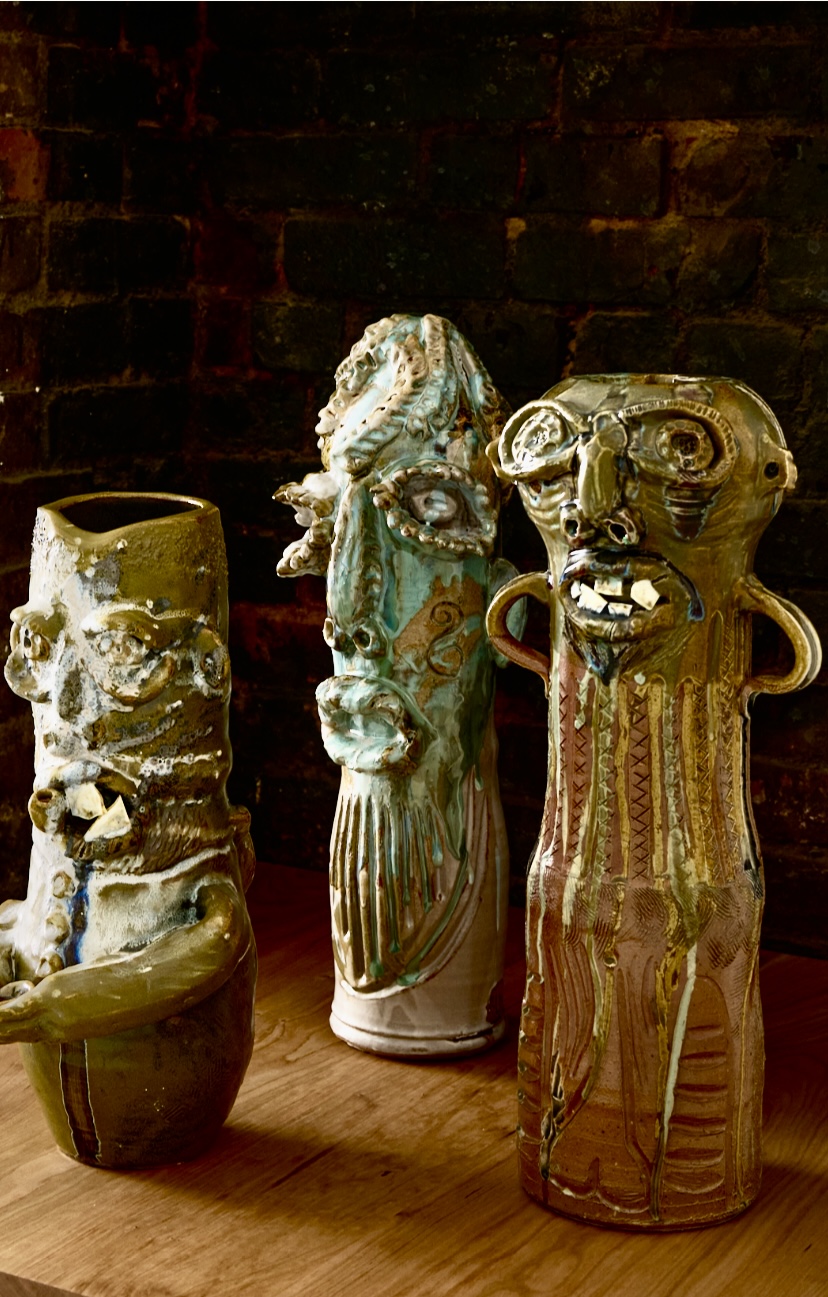 “And third of all, I have all the information that they had, but more. I have experience. I know about the types and qualities of wood. I know about stacking and loading the wood; I know how to put the wood in there so it gets the most impact. I know how to position the pots.
“And third of all, I have all the information that they had, but more. I have experience. I know about the types and qualities of wood. I know about stacking and loading the wood; I know how to put the wood in there so it gets the most impact. I know how to position the pots.
“You know, our ancestors were involved with every facet of that. They went and got the clay, and they processed the clay. They built the kilns, they cut the wood, they stacked the wood, and they dried the wood. They did everything. And so what I've done over the years is learn just about every facet of pottery to create this thing. This is also a part of the ancestors' work, where we remember that the information and the tools and things that they had were foundational, but now I can take that information and augment it and take it to the advances, take it to the highest level.
“But, you know, Jack Troy and Kevin Crowe, they are the experts.”
Jim articulates a justified frustration with the appropriation of Black cultural traditions – such as the face jug – by white artists, while also expressing deep gratitude for his lineage within the wood-firing community, maintaining a deliberate and reflective balance between critique and reverence. Yet embedded in his narrative is a quiet sorrow as he contemplates the uncertain future faced by the next generation. Jim notes, more than once, the absence of young Black potters at his kiln. He doesn’t dwell on this imbalance, but it haunts the margins of the conversation: what happens to these stories and techniques if the next generation does not arrive to receive them?
Jim describes, “It's taken a long time to get to this spot. Now, I have a kiln here on my property. It was designed by a guy named Joe Finch in England. He created these wood-gas kilns. A friend here, George Rolland of Village Potters in West Asheville, helped me modify it some and build it.
“Because I live in a residential area, I can't have a wood kiln. It is a gas kiln, but above the gas is the firebox. So every twenty to forty minutes, I throw in pieces of the wood. I’m using tropical wood, and it creates ash that lies on that hot pot and melts. I can get away with it here because I'm not making a lot of smoke, but this is only because of the knowledge I've gained from working with other potters. There's always a way to get around it – the smoke. I want wood, first and foremost. It takes about thirteen hours to fire this kiln. It's about a forty-cubic-foot kiln that can be used for gas or wood. It's one firebox coming in this way and one coming in on the opposite side, that way.
“At my age now – I'm almost 80 – I can't do this by myself. But I'll keep going. I love teaching. I love showing people how to do it, and I love sharing what I have here, because I have a lot. You know, I can't hold on to it and not share.”
As Jim shares his experience, a revelatory sense of continuity emerges – between his hands and the wheel, the presence of ancestors who guide him, and the fire that brings his work to life. He is a man deeply grounded with a forward-facing presence of matter-of-factness, yet equally attuned to the deeper currents of philosophy and emotion that root him in his ancestry and give his work its unmistakable power.
“The more I delve into the face jugs, the more the ancestors express to me how they want to be remembered. Because who is the jug for?
“Well, we [Black Americans] got so many stories (Jim references our earlier conversations on David Drake, Emmett Till, George Floyd, Miss Cissy, and more). I did one the other day about Senator Cory Booker. He did something miraculous. He held the floor of the Senate for twenty-five hours and five minutes. So I made him one in his likeness to mark the accomplishment, and on the back of it, I wrote what he did – that he held the Senate floor for that long and that he was telling what the evils were that this current president was doing. I try to honor not only our people but white people too – Mother Teresa, Ruth Bader Ginsburg – people who have contributed to society in general.
“And where does it come from? It comes out of anger.
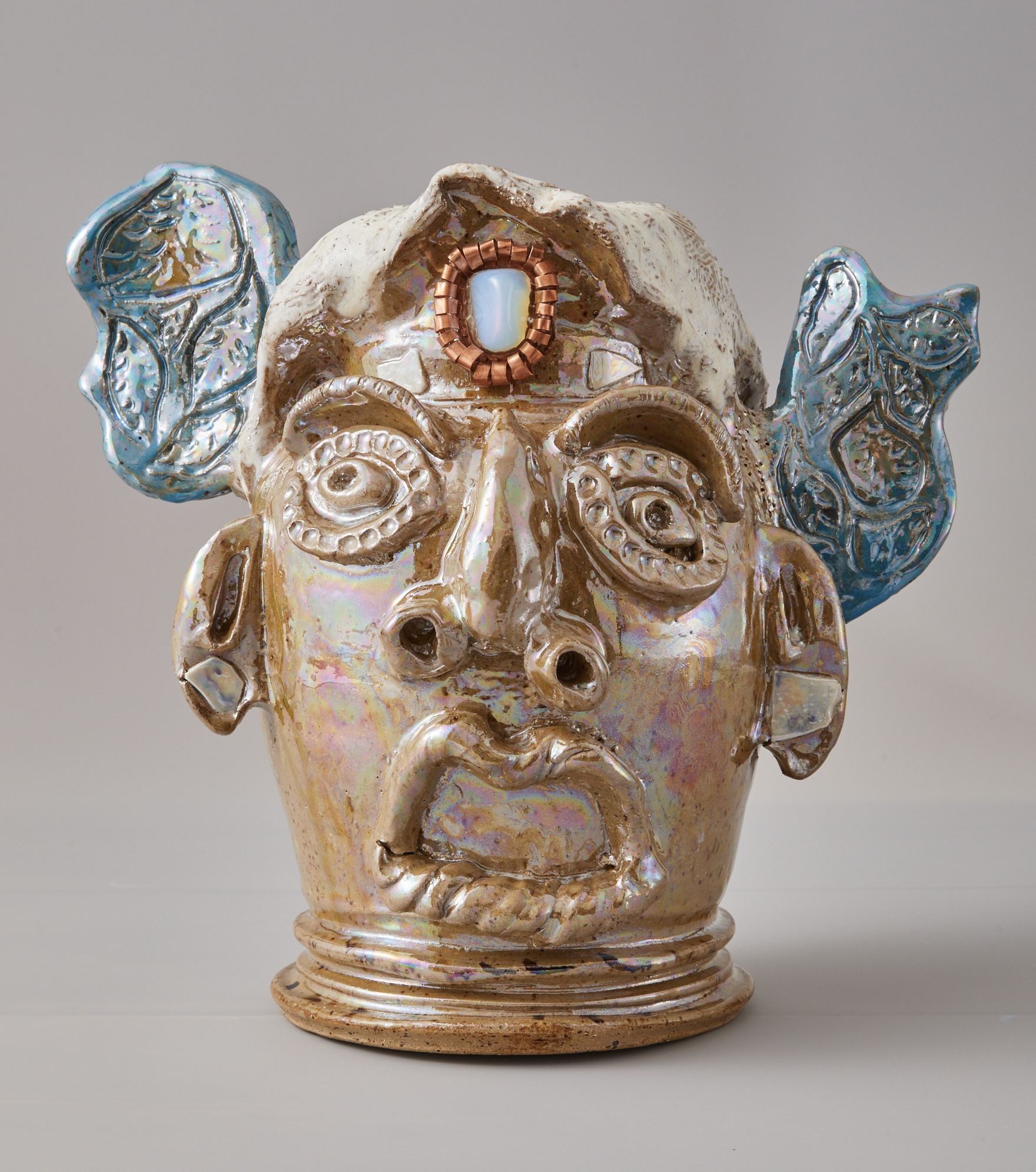 “You know, I'm not trying to make a statement so that people will listen to me, because these jugs are going to live on long after I'm gone. But if I can take that anger and channel it into something that will last, something that is culturally significant. I realized that I'm on the backs of those who came before me. Those enslaved people who did everything, and I mean everything, and didn't get a dime. I realized the sacrifices that our people, my father, have made for me to get here.”
“You know, I'm not trying to make a statement so that people will listen to me, because these jugs are going to live on long after I'm gone. But if I can take that anger and channel it into something that will last, something that is culturally significant. I realized that I'm on the backs of those who came before me. Those enslaved people who did everything, and I mean everything, and didn't get a dime. I realized the sacrifices that our people, my father, have made for me to get here.”
Jim recounts one final story in our conversation about his father, James T. McDowell Sr., who served in WWII prior to Jim’s birth in 1945 and stayed in the service for several years after that. He was an artist who worked as a guard at the Pentagon while aspiring to become an illustrator. Despite facing racism during his daily commute, Jim narrates, “The bus driver could not wait to say, ‘Niggas get in the back.’ My father endured that for us.”
“The Pentagon had an art show for all the service areas. He won the art show two years in a row with his paintings, and he got into a training program for his illustrations because he won. That was prestigious, so he did it. He got that job as an illustrator at the Naval Research Laboratory in the Fifties.” Jim reflects on this legacy with veneration, noting that his father never received the same level of recognition that Jim is now experiencing. Jim’s work has been exhibited nationally and internationally, including at Cubitt Gallery in London, 4-F Gallery in Los Angeles, and the Walter Anderson Museum of Art in Mississippi. He has been featured in independent films and on television networks such as PBS’s History Detectives. His accolades include an Andy Warhol Museum Grant and awards from the Heinz Foundation. His work is featured in collections that include The Krannert Art Museum at the University of Illinois, the North Carolina Museum of History, Los Angeles County Museum of Art (LACMA), the Nasher Museum of Art at Duke University, the Birmingham Art Museum, and the Ogden Museum of Southern Art in New Orleans, to name a few. He has also taught at esteemed institutions like the Chautauqua Institution and the Winterthur Museum.
This holistic framing of technique within lived experience is part of what makes McDowell’s voice so singular – and so necessary – in the broader landscape of ceramic discourse. His refusal to separate process from purpose, form from politics, or tradition from innovation pushes back against historic gatekeeping while asserting a standard of excellence rooted in survival, mastery, and meaning. His voice calls us to listen more closely: to our materials, to our ancestors, and to the communities we build through the act of making.

